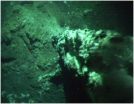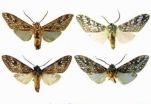(Press-News.org) Cichlid fish are more likely to accept immigrants into their group when they are under threat from predators and need reinforcements, new research shows. The researcher suggests that there are parallels between cooperatively breeding fish's and humans' regulation of immigrants. The research was published today, 6 February 2013, in the journal Proceedings of the Royal Society B.
The Princess of Lake Tanganyika (Neolamprologus pulcher), a cichlid fish which is popular in home aquariums, are cooperatively breeding fish with a dominant breeding pair and several 'helper' fish that do not normally breed but instead assist with raising offspring. Helpers also play a crucial role in defending the group's territory against outsiders – although helpers also compete with the breeders for resources and reproductive opportunities.
The researchers, led by Dr Markus Zӧttl of the University of Cambridge, wanted to find out how environmental pressures might influence the acceptance of new immigrants. He said: "All animal societies are affected in one or another by immigration and when we seek to understand social organisation we need to understand which environmental factors influence processes like immigration."
A subdivided tank was used to carry out a series of tests in which different scenarios were observed. For the study, a breeding pair (which would be responsible for deciding whether a newcomer would be allowed to join the group) was placed in one compartment next to a compartment containing either a fish predator, an egg predator, a herbivore fish or no fish at all. An immigrant was placed in a third, adjoining compartment. The breeding pair was then exposed to the different fish in compartment two. The researchers then observed whether the type of fish they were exposed to would affect whether they accepted the immigrant fish from the third compartment.
The researchers found that breeders are less aggressive to immigrants and more likely to accept the unknown and unrelated fish as a member of their group when they are simultaneously exposed to predators. They concluded that cichlid fish are more likely to accept immigrants into their group when they are under threat from predators and can be used to increase their defences.
Dr Zӧttl added: "Our fish resemble human societies' view of immigration in two crucial aspects: The need for help in the territory takes precedence, and it seems to be a strategy of the territory holders to accept immigrants only when they need assistance with territory defence. This resembles human societies which organise immigration according to the demand in the society by encouraging skilled immigration when certain types of labour are in short supply."
The researchers also found that the fish appear to consider future threats. When egg predators were presented to a breeding pair who had not yet spawned they accepted new incomers. Their acceptance of reinforcements in the form of immigrant fish suggests that that the egg predator was viewed as a threat.
Dr Zӧttl concluded: "This behaviour suggests that breeders of this species might be able to anticipate a potential threat – and it seems to resemble the future planning evident in birds and apes."
###
For additional information please contact:
Genevieve Maul
Office of Communications
University of Cambridge
Tel: direct, 44-1223-332300
Mob: 44-7774-017464
Notes to editors:
1. The paper 'Group size adjustment to ecological demand in a cooperative breeder' will be published in the 06 February 2013 edition of Proceedings of the Royal Society B.
2. Images available upon request.
Environmental factors determine whether immigrants are accepted by cooperatively breeding animals
Perceived risk of predation increased acceptance of immigrants into group
2013-02-06
ELSE PRESS RELEASES FROM THIS DATE:
Nothing fishy about swimming with same-sized mates
2013-02-06
Have you ever wondered why, and how, shoals of fish are comprised of fish of the same size? According to new research by Ashley Ward, from the University of Sydney in Australia, and Suzanne Currie, from Mount Allison University in Canada, fish can use a variety of different sensory cues to locate shoal-mates, but they are able to use chemical cues to find other fish of the same size as themselves. Using these cues, they can form a group with strength in numbers. The work is published online in Springer's journal, Behavioral Ecology and Sociobiology.
Forming groups is ...
Biocontrol research on Brazilian peppertree in Florida discovers new cryptic species
2013-02-06
Dr Michael Pogue, a Research Entomologist in the ARS Systematic Entomology Laboratory, at the Smithsonian Institution, Washington, DC, was sent a series of moth specimens from Bahia, Brazil, for identification. The insects were under consideration as a possible biocontrol agent for the invasive Brazilian peppertree in Florida.
'The species was initially identified as a common species, but when comparisons were made, it became evident that there were multiple species involved' said Dr. Pogue. Using characters from the moths' male and female genitalia, Dr. Pogue determined ...
Widely used nanoparticles enter soybean plants from farm soil
2013-02-06
Two of the most widely used nanoparticles (NPs) accumulate in soybeans — second only to corn as a key food crop in the United States — in ways previously shown to have the potential to adversely affect the crop yields and nutritional quality, a new study has found. It appears in the journal ACS Nano.
Jorge L. Gardea-Torresdey and colleagues cite rapid increases in commercial and industrial uses of NPs, the building blocks of a nanotechnology industry projected to put $1 trillion worth of products on the market by 2015. Zinc oxide and cerium dioxide are among today's most ...
Study of a rare disease making people look like a woman but having male genitals under study
2013-02-06
University of Granada researchers have designed a guideline for physicians and patients on the Androgen Insensitivity Syndrome (AIS), a rare disease that makes the subject develop reverse sex, which occurs when a subject looks like a woman but has male genes.
AIS has low prevalence (it only affects one in 2000 people), and it is characterized by the inability of tissues to respond to the action of male hormones. This prevents individuals with XY sex hormones (i.e. 46,XY) to develop male genitalia. This disorder is caused by a mutation in the gene that codifies the receptor ...
Being overweight linked to higher risk of gum disease
2013-02-06
CHICAGO (Feb. 6, 2013)—Impacting approximately one-third of the U.S. population, obesity is a significant health concern for Americans. It's a risk factor for developing type 2 diabetes, heart disease, and certain forms of cancer, and now, according to an article published in the January/February 2013 issue of General Dentistry, the peer-reviewed clinical journal of the Academy of General Dentistry (AGD), it also may be a risk factor for gum disease.
"We know that being overweight can affect many aspects of a person's health," says Charlene Krejci, DDS, MSD, lead author ...
The European Space Sciences Committee reacts
2013-02-06
European Science Foundation's ESSC comments the decisions taken (or not) at ESA's council meeting at ministerial level.
Strasbourg – 6, February, 2013 - The European Space Sciences Committee (ESSC) today released its position on the perspectives for the European Space Agency's (ESA) scientific programmes. The position statement provides recommendations on the outcomes of the ESA council meeting at ministerial level, which took place on 26-27 November 2012 in Naples.
The statement comments on the impact for science-relevant ESA's programmes resulting from the decisions ...
Learning from the linker
2013-02-06
Mature cells can be reprogrammed to pluripotency and thus regain the ability to divide and differentiate into specialized cell types. Although these so-called induced pluripotent stem cells (iPS cells) represent a milestone in stem cell research, many of the biochemical processes that underlie reprogramming are still not understood. Scientists from the EMBL Hamburg and from the Max Planck Institute for Molecular Biomedicine in Münster, Germany now shed new light on this process. In a study published today in Nature Cell Biology, the scientists describe important details ...
Shimmering water reveals cold volcanic vent in Antarctic waters
2013-02-06
The location of an underwater volcanic vent, marked by a low-lying plume of shimmering water, has been revealed by scientists at the National Oceanography Centre, Southampton.
Writing in the journal PLOS ONE the researchers describe how the vent, discovered in a remote region of the Southern Ocean, differs from what we have come to recognise as "classic" hydrothermal vents. Using SHRIMP, the National Oceanography Centre's high resolution deep-towed camera platform, scientists imaged the seafloor at Hook Ridge, more than 1,000 metres deep.
The study, funded by the ...
Targets of bully bosses aren't the only victims, new UNH research shows
2013-02-06
DURHAM, N.H. – Abusive bosses who target employees with ridicule, public criticism, and the silent treatment not only have a detrimental effect on the employees they bully, but they negatively impact the work environment for the co-workers of those employees who suffer from "second-hand" or vicarious abusive supervision, according to new research from the University of New Hampshire.
In the first ever study to investigate vicarious supervisory abuse, Paul Harvey, associate professor of organizational behavior at UNH, and his research colleagues Kenneth Harris and Raina ...
ZooKeys opens the gates to America's moth diversity
2013-02-06
Since its inception in 2009, the "Contributions to the systematics of New World macro-
moths" series in ZooKeys has been playing an important role in publishing taxonomic changes and new discoveries concerning moth diversity in North America. With a total of 49 publications by 38 authors, this well-established series is among the topic leaders, alongside publications such as Canadian Staphylinidae.
Geographic coverage in Zookeys has previously focused primarily on the North American fauna (Canada, United States and Mexico). This issue marks a rapid acceleration in contributions ...
LAST 30 PRESS RELEASES:
UF dives deep into predicting storm damage with computer models
A stormy ocean voyage yields insights on the global carbon cycle
Scientists identify first non-coding gene that controls cell size
Demonstration of altermagnetism in RuO₂ thin films -- A new magnetic material for the AI era
Penn researchers awarded $25M to conduct trial using smartphones to fight heart disease
PCORI awards funding for new patient-centered healthcare research
Exploring the origins of the universe: 145 low-noise amplifiers complete ALMA telescopes
Empress cicada wings help illuminate molecular structure
Using sound waves to detect helium
Time burden in patients with metastatic breast and ovarian cancer from clinic and home demands
Researchers discover bias in AI models that analyze pathology samples
Scientists ID potential way to prevent brain injuries from triggering Alzheimer's
MASTER 2nd Open Call: Execution period kick-off
Algae for health in food and pharma
Advanced microrobots driven by acoustic and magnetic fields for biomedical applications
Chicago health information leader recognized for raising CPR readiness and blood pressure awareness
The Intimate Animal, a new book from Kinsey Institute Executive Director Dr. Justin Garcia
When blue-collar workers lose union protection, they try self-employment
New video dataset to advance AI for health care
MEA-based graph deviation network for early autism syndrome signatures in human forebrain organoids
New modeling approach sheds light on rare gut disease
Study documents potentially hazardous flame retardants in firefighter gear
Can certain bacteria regulate aging of the immune system and its related alterations?
AI model helps diagnose often undetected heart disease from simple EKG
There are fewer online trolls than people think
Cell membrane fluctuations produce electricity
Jeonbuk National University study shows positive parenting can protect adolescents against self-harm
Surface-engineered ZnO nanocrystals to tackle perfluoroalkyl substance contamination
This new understanding of T cell receptors may improve cancer immunotherapies
A new fossil face sheds light on early migrations of ancient human ancestor
[Press-News.org] Environmental factors determine whether immigrants are accepted by cooperatively breeding animalsPerceived risk of predation increased acceptance of immigrants into group


